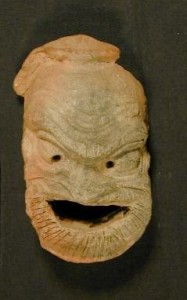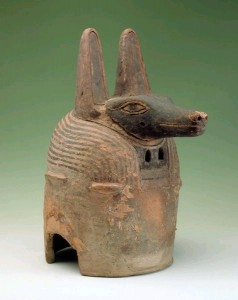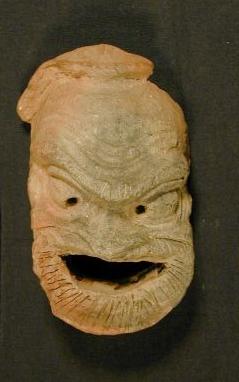What is the oldest surviving prop in the world? It is a tricky question, as we often are unable to tell whether something was a prop or an actual object. In my article about props in Molière’s time, we saw that one of the chairs originally used in his plays is still displayed at the La Comédie-Française. I’ve yet to find earlier examples, but I’ll admit my research in that area is just beginning. There are, however, some examples of masks from earlier times.
Some may question whether masks are actually props. Often they are considered costumes, and in some cases, they can be considered a completely separate department. However, I feel that because they are physical objects of the theatre, they are worth investigating for historical purposes. In Ancient Greek theatre, the mask-makers were the same craftsmen who would make other theatrical props called for in the show (read my article on Ancient Greek Theatre props for more information), and it is not implausible to believe that such was the case in other theatrical traditions.
I would like to add one further caveat as well before continuing. Masks were used in many early societies as parts of rituals. Ancient Greek theatre rose out of such rituals, and many other early rituals evolved into forms of theatre as well. While rituals are not theatre per say, they can be considered part of the theatrical tradition. In any event, masks and mask-makers may be viewed as the earliest predecessors of props and prop artisans.
Though no Greek theatre masks have survived to the modern day, we have some examples of Roman New Comedy masks which have evolved out of the Greek tradition.

Many early theatre traditions made masks out of leather or hide, and included feathers and fur as decorations. While clay and stone masks may been less prevalent, they are the only kinds which have survived, as anything organic has long since decomposed.
Preceding the Greeks were the Ancient Egyptians. Here we see a ceramic Anubis mask, one of the only surviving helmet masks from Egypt.

Currently held in the Hildesheim Pelizaeus-Museum, the mask weighs about 17 pounds and is believed to date from about 600BCE. Notice the two holes below the head; these are eye-holes for the priest who wore it. Unlike the Roman mask above, this mask was used in a more ceremonial rather than theatrical purpose.
One of the oldest masks believed to be in existence is this stone mask from the neolithic period.

Dating from 7000BCE, the mask is currently held at the Musée de la Bible et de la Terre Sainte in France, which displays artifacts from the Palestinian area.
The Mask Makers Web has far more information about Mask Traditions around the world if you are so interested.

